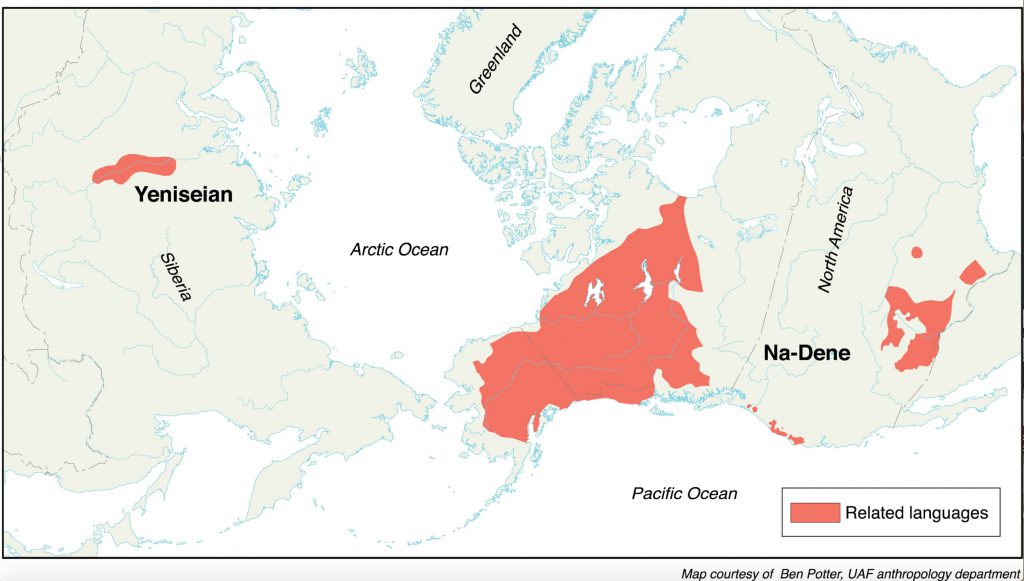About the Symposium

Dene (or Athapaskan/Athabascan) peoples constitute the largest and, arguably, the most geographically widespread Indigenous group in North America [see Map A]––or possibly the world, if the current Dene-Yeniseian hypothesis continues to receive strong supporting evidence. This hypothesis links the North American Dene with a number of linguistic groups living along the Yenisei River in Western Siberia [see Map B]. Both maps give only a static and highly colonialized point of view and only hint at the many great wanderings and returns that Dene people regularly engaged in. Stories from Dene Elders contain information about these travels, as well as recurring themes that bind Dene people together even today (such as a lost child, a captive woman, a fight over a dog, a forked stick in the hearth, monster birds, and the presence of giants and little people).
In the 18th century, during the beginning of intense European colonization of the North American continent, there were estimated to have been well over 50 Dene languages, of which about 40 survive today. There are still 4 Dene languages spoken in the Province of Alberta, a territory that could be thought of as a kind of geographic centre of the contemporary Dene world and whose lands were likely part of the migration corridor to the American southwest. Moreover, some Dene Elders claim there were Dene incursions deep into Mexico and Central America before European expansion began. This extensive migratory spread across the western half of North America and beyond was not necessarily accompanied by sizeable or dense settlements. Fundamentally, Dene people practiced a traditional hunter-gatherer lifestyle, living and traveling in small, familial bands. What is distinct about the Dene is the size of the land base that they traveled to and settled in. Traditionally, Dene peoples often lived at the margins of more populous and stratified Indigenous societies, with whom they might have traded and inter-married, sharing cultural practice, but never losing or blending the distinctive features of their language(s).

For linguists, Dene languages are unique because they uniformly present very large and unusual sound inventories, complex verb systems, and astounding lexico-syntactic conservatism––in other words, the daughter languages of this large family look remarkably alike in structure and vocabulary.
For anthropologists, Dene peoples manifest astounding cultural adaptability, since they have tended to adopt the dress, diet, life-style, ceremony, and cosmology of their neighbors––in other words, different Dene groups look remarkably different from each other in terms of cultural practice.
For archaeologists, the Dene present one of the biggest mysteries with respect to human settlement and migration patterns in prehistory North America. The Dene have dispersed across the continent in both fan-like and leap-frog patterns, leaving little in the way of a decisive archaeological record.
For Dene people, there may be uneven knowledge of or even failure to acknowledge the magnitude of the greater Dene Nation, both geographically and historically. Yet, the story of the Dene diaspora may be one of the most compelling in all human experience.
Although widely varying cultural practice makes Dene descendants look very distinct from one another ethnographically speaking, Dene peoples continue to share certain common stories about separation. Whether this is to be taken as North American-Siberian separation, Alaska/Yukon-Canadian interior separation, or North-South separation, migration and return represent culturally charged––and widely shared––notions. Since we all have holes in our stories, in this second symposium, we want to share what we know, what we’ve come to know based on recent evidence, and what we still don’t know about Dene migration across the continent(s) so we can start to mend the holes in our knowledge about one of the most remarkable human dispersions in history.
This symposium is a small part of a larger project which seeks to challenge and change traditional Western assumptions about Dene migrations. We hope to integrate traditional knowledge of speakers with linguistic, ethnographic, and material culture knowledge as preparation for the development of a single, searchable, and expandable on-line database documenting the scientific story of Dene peoples as well as the traditional stories and historical knowledge of the Dene themselves. This database, tentatively titled the Living Digital Archive of Dene Languages and Cultures, will contribute to the documentary record about the languages and life-ways of Dene peoples in present-day Canada and the United States, who together represent a rich, ethnically diverse, and growing presence in shaping political, societal, and educational discourse in both countries.